Related Research Articles
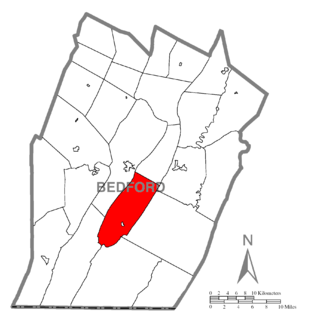
Colerain Township is a township in Bedford County, Pennsylvania, United States. The population was 1,127 at the 2020 census.

Snake Spring Township is a township in Bedford County, Pennsylvania, United States. The population was 1,830 at the 2020 census.

The Little Juniata River, sometimes called the "Little J," is a 32.1-mile-long (51.7 km) tributary of the Juniata River in the Susquehanna River watershed of Pennsylvania. It is formed at Altoona by the confluence of several short streams. It flows northeast in the Logan Valley at the foot of Brush Mountain.

Mount Nittany is the common name for Nittany Mountain, a prominent geographic feature in Centre County, Pennsylvania, United States. The mountain is part of a ridge that separates Nittany Valley from Penns Valley, with the enclosed Sugar Valley between them. On USGS topographic maps, Nittany Mountain is generally shown as the lower ridge line that runs below Big Mountain on the west and Big Kettle Mountain on the east side, coming together to form a single ridge line at the southern terminus. This nomenclature is not always consistently applied to the same geologic formation, and there is a shorter Nittany Mountain ridge shown above the Sugar Valley as well.

The Frankstown Branch Juniata River is a 46.0-mile-long (74.0 km) tributary of the Juniata River in Blair and Huntingdon counties, Pennsylvania, in the United States.

The Bald Eagle Valley of central Pennsylvania, United States, is the low-lying area draining into Bald Eagle Creek between the Allegheny Front and Bald Eagle Mountain, south of the West Branch Susquehanna River, in the Ridge-and-valley Appalachians. It is southwest of the West Branch Susquehanna Valley that includes Williamsport and northwest of the Nittany Valley that includes State College.

Bald Eagle Mountain – once known locally as Muncy Mountain – is a stratigraphic ridge in the Ridge-and-Valley Appalachians of central Pennsylvania, United States, running east of the Allegheny Front and northwest of Mount Nittany. It lies along the southeast side of Bald Eagle Creek and south of the West Branch Susquehanna River, and is the westernmost ridge in its section of the Ridge-and-Valley Appalachians. The ridge line separates the West Branch Susquehanna Valley from the Nippenose and White Deer Hole valleys, and Bald Eagle Valley from Nittany Valley.
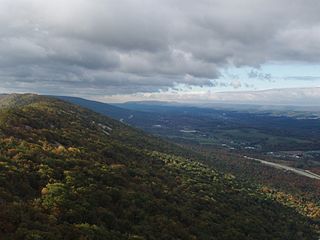
Brush Mountain is a stratigraphic ridge in the Appalachian Mountains of central Pennsylvania, United States, lying east of the Allegheny Front and west of Tussey Mountain. It runs along the southeast side of the Little Juniata River and forms a horseshoe around Sinking Run, and is the westernmost ridge in its section of the Ridge-and-valley Appalachians. The western ridge line separates the Logan Valley from the Sinking Valley.

Wills Mountain is a quartzite-capped ridge in the Ridge and Valley physiographic province of the Appalachian Mountains in Pennsylvania and Maryland, United States, extending from near Bedford, Pennsylvania, to near Cumberland, Maryland. It is the northernmost of several mountain ridges included within the Wills Mountain Anticline.
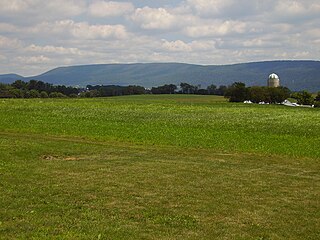
Tussey Mountain is a stratigraphic ridge in central Pennsylvania, United States, trending east of the Bald Eagle, Brush, Dunning and Evitts Mountain ridges. Its southern foot just crosses the Mason–Dixon line near Flintstone, Maryland, running north 130 km (80 mi) to the Seven Mountains of central Pennsylvania, near Tusseyville, making it one of the longest named ridges in this section of the Ridge-and-valley Appalachians. The ridge line separates Morrison Cove from the Woodcock Valley and Friends Cove from the Black Valley. Tussey Mountain lies in, and the ridge line forms parts of the borders of, Centre, Blair, Bedford and Huntingdon counties.

The Ordovician Martinsburg Formation (Om) is a mapped bedrock unit in Pennsylvania, New Jersey, Maryland, Virginia, and West Virginia. It is named for the town of Martinsburg, West Virginia for which it was first described. It is the dominant rock formation of the Great Appalachian Valley in New Jersey (where it is called Kittatinny Valley and Pennsylvania.
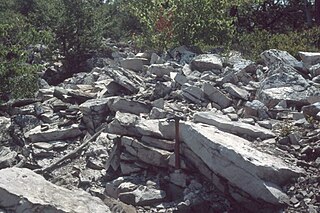
The Silurian Tuscarora Formation — also known as Tuscarora Sandstone or Tuscarora Quartzite — is a mapped bedrock unit in Pennsylvania, Maryland, West Virginia, and Virginia, USA.

The Ordovician Juniata Formation is a mapped bedrock unit in Pennsylvania and Maryland. It is a relative slope-former occurring between the two prominent ridge-forming sandstone units: the Tuscarora Formation and the Bald Eagle Formation in the Appalachian Mountains.

Bedford County, Pennsylvania is situated along the western border of the Ridge and Valley physiographic province, which is characterized by folded and faulted sedimentary rocks of early to middle Paleozoic age. The northwestern border of the county is approximately at the Allegheny Front, a geological boundary between the Ridge and Valley Province and the Allegheny Plateau.
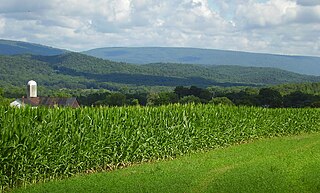
Jacks Mountain is a stratigraphic ridge in central Pennsylvania, United States, trending southeast of the Stone Mountain ridge and Jacks Mountain Anticline. The ridge line separates Kishacoquillas Valley from the Ferguson and Dry Valleys. Jacks Mountain lies in Mifflin, Huntingdon, Snyder, and Union Counties, and the ridge line forms part of the border between Huntingdon and Mifflin Counties.

The Ordovician Reedsville Formation is a mapped surficial bedrock unit in Pennsylvania, Maryland, Virginia, West Virginia, and Tennessee, that extends into the subsurface of Ohio. This rock is a slope-former adjacent to the prominent ridge-forming Bald Eagle sandstone unit in the Appalachian Mountains. It is often abbreviated Or on geologic maps.
Stone Mountain is a stratigraphic ridge in central Pennsylvania, United States, trending northwest of the Jacks Mountain ridge and Jacks Mountain Anticline. The ridge line separates Kishacoquillas Valley from the Seven Mountains area. Stone Mountain lies in, and the ridge line forms part of the border between, Mifflin and Huntingdon counties.
The Devonian Mahantango Formation is a mapped bedrock unit in Pennsylvania, West Virginia, and Maryland. It is named for the North branch of the Mahantango Creek in Perry and Juniata counties in Pennsylvania. It is a member of the Hamilton Group, along with the underlying the Marcellus Formation Shale. South of Tuscarora Mountain in south central Pennsylvania, the lower members of this unit were also mapped as the Montebello Formation. Details of the type section and of stratigraphic nomenclature for this unit as used by the U.S. Geological Survey are available on-line at the National Geologic Map Database.
The Ridgeley sandstone is a sandstone or quartzite of Devonian age found in the Appalachian Mountains of Pennsylvania, Maryland, West Virginia, and Virginia, United States. The Ridgeley is fine-grained, siliceous, calcareous in its lower strata, sometimes fossiliferous, and sometimes locally pebbly or conglomeritic. Varying in thickness from 12 to 500 feet, this rock slowly erodes into white quartz sand that often washes or blows away, but sometimes accumulates at large outcrops. When freshly broken, the rock is white, but outcrop surfaces are often stained yellowish by iron oxides.

Dunning Mountain is a stratigraphic ridge in central Pennsylvania, United States. The mountain's north end is at McKee Gap, which separates it from Short Mountain, and where Halter Creek flows westward towards the Frankstown Branch of the Juniata River. The south end of the mountain is contiguous with Evitts Mountain, but is marked by a sharp bend to the east. The valley formed by the bend is known as "The Kettle," and the broad valley to the east of Dunning Mountain is called Morrisons Cove. The town of Roaring Spring is located at the north end of the mountain on the east side.
References
- ↑ Pennsylvania State Game Lands Number 166, retrieved 14 November 2018
- ↑ Berg, Thomas M., and Dodge, Christine M., eds., Map 61, Atlas of Preliminary Geologic Quadrangle Maps of Pennsylvania, Bureau of Topographic and Geologic Survey, 1981 (Spruce Creek Quadrangle, Frankstown Quadrangle)